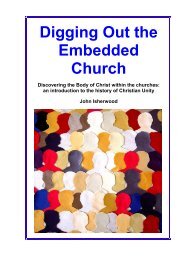Christian Unity (the book) - The Maranatha Community
Christian Unity (the book) - The Maranatha Community
Christian Unity (the book) - The Maranatha Community
Create successful ePaper yourself
Turn your PDF publications into a flip-book with our unique Google optimized e-Paper software.
<strong>the</strong> Person of Christ. This was <strong>the</strong> form of <strong>Christian</strong>ity that first reached <strong>the</strong> FarEast (China) in <strong>the</strong> 8 th Century, as witnessed by <strong>the</strong> Sigan-fu Stone. 15Nestorius was challenged to say whe<strong>the</strong>r he could call <strong>the</strong> Virgin Mary‘<strong>The</strong>otokos’ (God-bearer) and ‘Mo<strong>the</strong>r of God’. He rejected <strong>the</strong>se terms andcould not conceive how <strong>the</strong> divine logos could be totally one with <strong>the</strong> humanJesus. Christ was one Person, with two distinct natures. So in Jesus <strong>the</strong>re was<strong>the</strong> Christ born of Mary (so he could use <strong>the</strong> term ‘Christotokos’), and <strong>the</strong>rewas also <strong>the</strong> ‘Son of God’.Nestorianism lingered on in <strong>the</strong> East and only disappeared from Kurdistanduring <strong>the</strong> First World War.MonophysitismIn <strong>the</strong> 5 th Century a completely different perspective of <strong>the</strong> Person of Christwas seen in Monophysitism (from <strong>the</strong> Greek monos meaning ‘one, alone’ andphysis meaning ‘nature’). Unlike Nestorianism, it saw only one nature in Christ:<strong>the</strong> human nature was absorbed into <strong>the</strong> divine at <strong>the</strong> Incarnation.Both Nestorianism and Monophysitism were attempts to try to define <strong>the</strong>relationships of <strong>the</strong>se two natures, human and divine, in Christ. Athanasius hadwritten about a ‘natural union’ (henosis phusikos) but he wisely did notattempt to define <strong>the</strong> mode of that union. Nestorianism held that <strong>the</strong> union of<strong>the</strong> two natures was a moral union, that is, <strong>the</strong> more Jesus ‘<strong>the</strong> man’ acted intune with God, <strong>the</strong> closer he came to union with ‘<strong>the</strong> logos’. <strong>The</strong> heart ofMonophysitism is to be found in <strong>the</strong> assertion that <strong>the</strong>re is but one nature, <strong>the</strong>divine, in Christ.A A Luce, in his work on Monophysitism, 16 points out <strong>the</strong> serious implicationsof <strong>the</strong> Monophysite view for <strong>Christian</strong> <strong>the</strong>ology. He believed it tended toreduce appreciation of Jesus as human; his sufferings and passion are played15<strong>The</strong> Sigan-fu Stone (North West China). A Nestorian tablet from 781 AD found in <strong>the</strong> early17 th Century. <strong>The</strong> inscription on it in Chinese gives evidence of a Nestorian missionary,Olopen (or Alopen) bringing his brand of <strong>Christian</strong>ity to China in <strong>the</strong> 8 th Century. See Cross,F L and Livingstone, E A, eds, <strong>The</strong> Oxford Dictionary of <strong>the</strong> <strong>Christian</strong> Church, OxfordUniversity Press, 1997.16Luce, A A, Monophysitism, Past and Present, SPCK, 1920.Page 30








